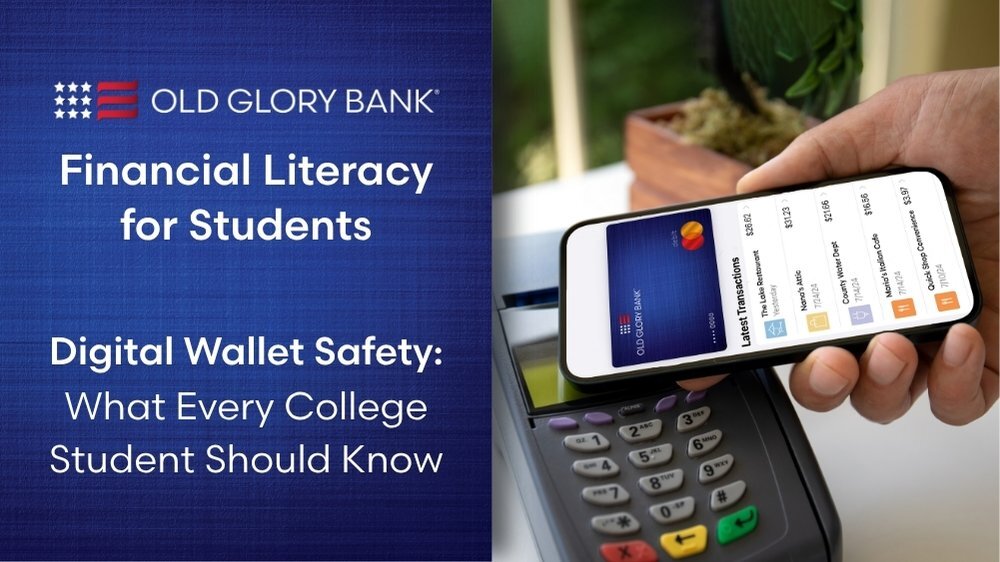In today’s fast-paced, tech-driven world, digital wallets have become go-to tools for students. Do you know how to use them responsibly?
We love our digital wallet, right? Apple Pay. Google Wallet. Venmo. Cash App. They're fast, convenient, and perfect for splitting pizza with friends or paying for coffee on the go. Besides, who carries cash anymore?
But with convenience comes responsibility. If you're using a digital wallet, it's essential to understand how to keep your money and your personal information safe.
What Is a Digital Wallet?
(Gen Z – Ignore this part. This is for your parents and grandparents who might not know.) A digital wallet is an app that securely stores your payment information, such as credit and debit cards, bank accounts, and even student IDs. It allows you to make purchases or send money using your phone, smartwatch, or computer.
Yet, our students are eager to learn. Budgeting, investing, avoiding debt, building credit, are common goals among today’s young adults. They value independence, personal freedom, transparency, and autonomy, all of which intersect with financial literacy. Those of us farther along on the timeline of life know that the financial habits we build in our twenties impact our lives for several decades, if not the rest of our lives.
Why Safety Matters
Digital wallets are generally secure, but they’re not immune to risks like:
- Phishing scams
- Lost or stolen devices
- Weak passwords
- Unsecured Wi-Fi networks
If your wallet is compromised, your financial and personal information could be at risk.
7 Tips to Keep Your Digital Wallet Safe
1. Use Strong, Unique Passwords
Avoid using the same password across multiple accounts.
Don't use your dog’s name, your birthday, your street name, or anything else that is easy for someone to find out. Use a password manager to create and store strong, unique passwords for each app.
Change your passwords often, and for crying out loud, don’t give your password to anyone else!
2. Enable Two-Factor Authentication (2FA)
Most digital wallets offer 2FA. This is also known as Multi-Factor Authentication (MFA). This adds an extra layer of security by requiring a second form of verification, like a text code (known as a Secure Access Code or SAC) sent to your phone.
Another common-sense reminder, but one we must repeat every chance we get – do NOT give out a Secure Access Code to anyone! EVERY SINGLE DAY, we hear about another scammer tricking someone into giving them an SAC, which is like handing over the keys to the front door of your house and showing them where the expensive electronics are.
If ANYONE calls or texts you claiming to be from Old Glory Bank (or the IRS, or an online store, or any other financial institution or government agency), telling you that your account has been hacked and they need to send you a code to verify who you are, THEY ARE LYING TO YOU. No actual bank or government agency will ask you to repeat this number back to them. It’s a criminal asking for the keys.
3. Lock Your Devices
Always use a passcode, fingerprint, or facial recognition to lock your phone and other devices. Set your device to autolock after 30 or 60 seconds of inactivity, in case you leave it on a desk at the library or at the coffee shop.
If a casual criminal walks by and picks up your phone, this prevents them from opening your digital wallet and quickly emptying it before you notice.
4. Avoid Public Wi-Fi for Transactions
Public Wi-Fi networks are often unsecured, and it’s easy for lurkers to digitally spy on you to gain access to your accounts. Avoid making payments or accessing your wallet on public networks unless you're using a VPN.
5. Pay Attention to your Accounts
“You gotta be knowing where your money is going!” Check your transaction history often. Daily, even. If you see anything suspicious, report it to your bank or wallet provider immediately.
6. Only Use Trusted Apps
Download digital wallet apps from official app stores. Avoid third-party apps that could be fake or malicious. Stick to just one or two trusted apps so you don’t have too many to keep up with, and the crooks don’t have back doors they can sneak through.
7. Be Cautious with Peer-to-Peer Payments
Only send money to people you know and trust. Scammers often use apps like Venmo or Cash App to trick users into sending money.
A common scam lately is someone asking to borrow your phone for a phone call. Instead, they quickly open one of your money apps and “pay” themselves. In seconds, a few hundred dollars is gone from your account, or worse.
If you do become the unfortunate victim of a crime like this, report it to police. There is very little chance of getting your money back, but you might help prevent another victim from getting snagged in the scheme.
Be Smart
Digital wallets are a great tool for students, especially at college, but like any financial tool, they require you to make some smart and safe decisions. By taking a few simple precautions, you can avoid the hassle of cash and enjoy the convenience of digital payments without putting your money or identity at risk.
More in our Student Financial Literacy Series
Understanding Crypto and Blockchain – A Guide for Students
Student Loans: The Real Cost of Borrowing
The Pursuit: Investing 101 - Growing Today’s Dollars Into ...

